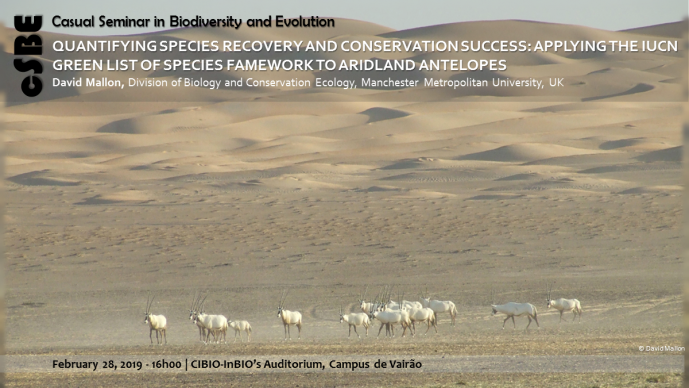QUANTIFYING SPECIES RECOVERY AND CONSERVATION SUCCESS: APPLYING THE IUCN GREEN LIST OF SPECIES FAMEWORK TO ARIDLAND ANTELOPES

CASUAL SEMINAR IN BIODIVERSITY AND EVOLUTION

Preventing and reversing biodiversity losses are crucial tasks, but are only the initial steps in re-establishing functioning ecosystems across landscape scales. The IUCN Green List of Species, currently under development, provides a conceptual framework for quantifying species recovery and conservation success. It builds on The IUCN Red List of Threatened Species to set more ambitious conservation goals and help drive sustained action. The Green List proposes a definition of a "fully recovered" species that includes the qualities of viability, functionality, and representation, and uses counterfactual approaches to quantify the extent of recovery and calculate metrics that demonstrate the impact of conservation efforts, the dependence of a species on conservation and the requirements for achieving full recovery over the long-term. These metrics are intended to incentivize the establishment and achievement of ambitious conservation targets. There are several challenges in applying the framework, some of which are exemplified by the extreme depauperation of the large mammal fauna of the deserts of North Africa and the Arabian Peninsula. Some ungulate and large carnivore species have been extirpated, several have been brought to the edge of extinction, and all others are threatened. The current range and population size of most extant species are less than 1% of their former levels while concomitant losses of intraspecific genetic diversity remain unquantified. In view of the greatly reduced abundance, local extinctions of grazers, and trophic truncation through removal of large carnivores, restoring fully functioning desert ecosystems is problematic, and arguably unrealistic: therefore a revised conservation vision for the region may be required.
David Mallon is a large mammal ecologist by academic training and carried out masters and PhD research in the Ladakh Himalaya of India. He is an Associate Lecturer in the Division of Biology and Conservation Ecology at Manchester Metropolitan University, UK, a Fellow of the Royal Geographical Society, and an Honorary Conservation Fellow, Zoological Society of London. He is a Special Advisor to the IUCN Species Survival Commission, a member of the IUCN Red List Committee and Co-Chair of the Antelope Specialist Group. Main current interests lie in strategic planning, species prioritisation, international conservation policy, and linking assessment, planning and effective action. He has been involved in many species conservation planning exercises covering a wide range of taxa.
[Host: José Carlos Brito, Biodiversity of Deserts and Arid Regions]
Image credits: David Mallon